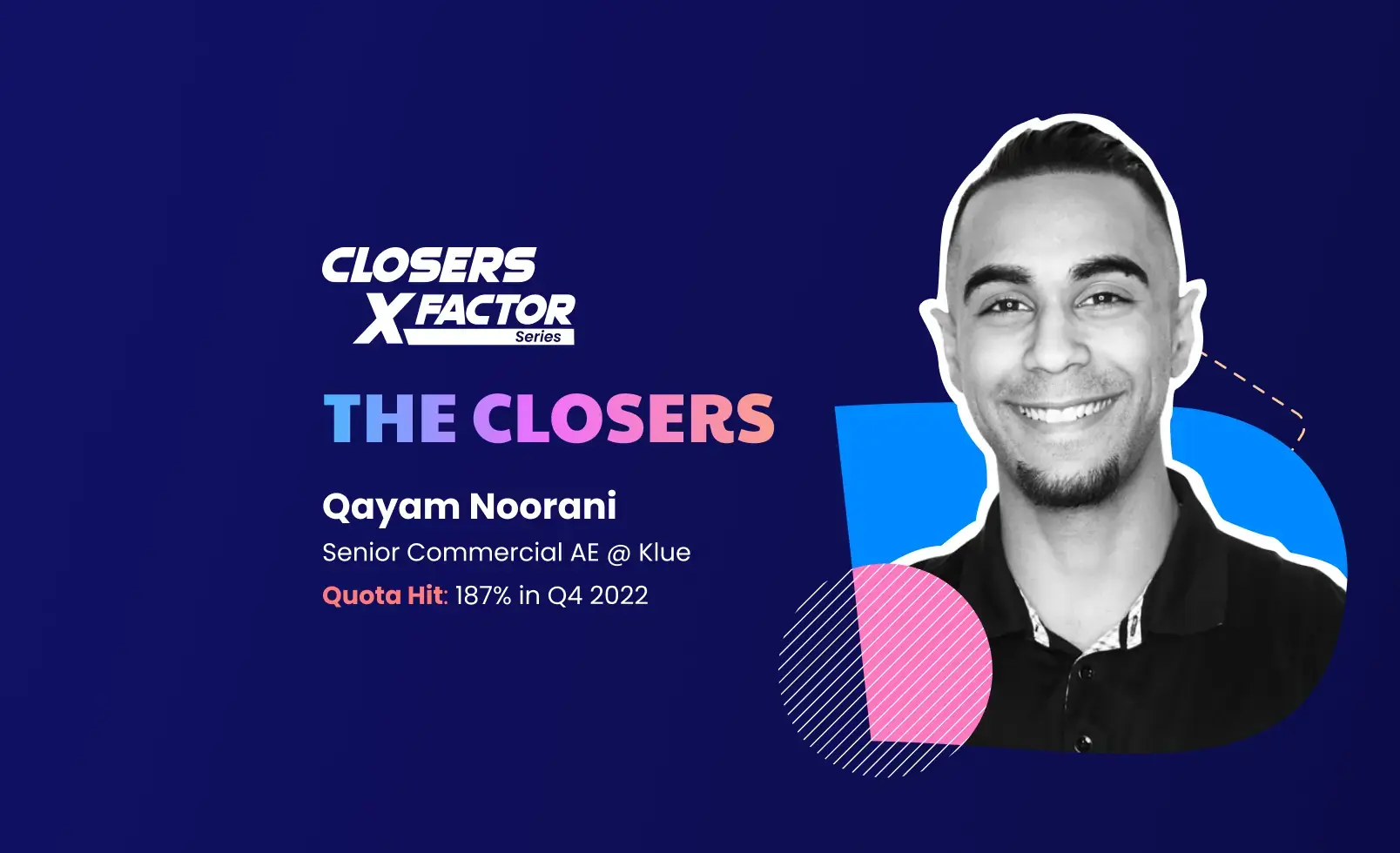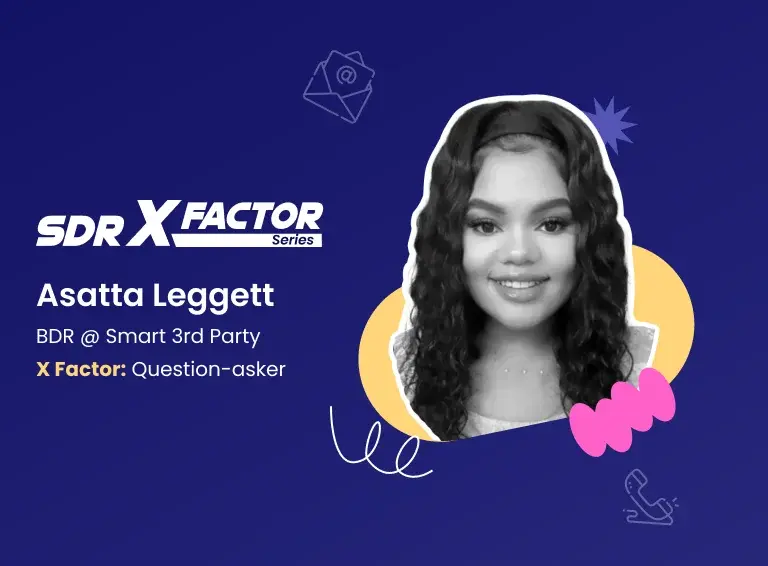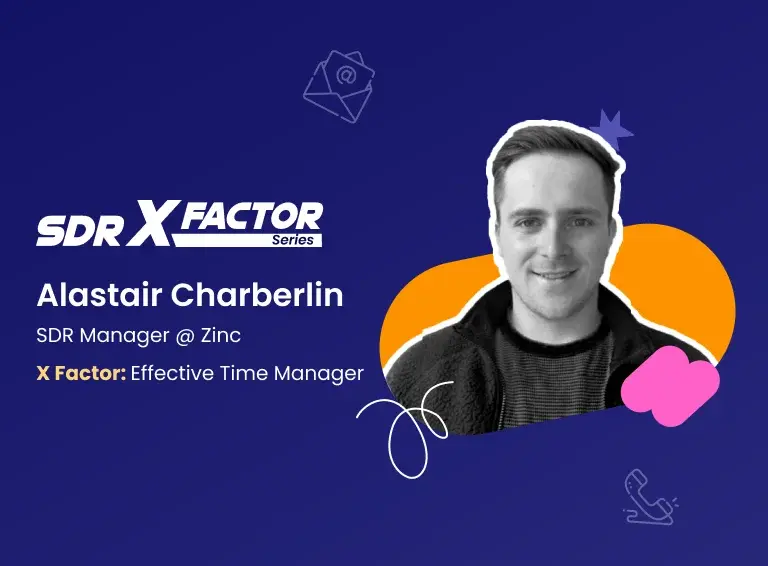Qayam Noorani landed a job out of college as a mortgage specialist at a reputed bank. This is the kind of job that’d leave most fresh graduates satisfied. But he wanted better.
He found out about Klue through a friend and loved what the company did. He was open to working there in any role and ended up as an SDR. Over 4 years later, he’s now the Senior Commercial Account Executive at the company that caters to enterprise sales teams.
As an AE, Qayam won $1.1 million in closed-won revenue for Klue. In Q4 2022, his quota attainment was a whopping 187%.
In this 4th episode, we reveal this rockstar AE’s razor-sharp approaches to running demo calls, how he builds urgency in the buyer, and all the behind-the-scenes activities that help him close massive deals and crush quota every time.
1) Qayam’s Super-Strategic Approach to Sales Discovery
Qayam doesn’t have a separate discovery call for his prospects. At his organization, the SDRs will do the discovery before handing the prospects over to the AEs.
His first call with prospects will usually be an hour long and includes a bit of discovery and the product demo. Here’s how he divides the call:
- 30 minutes for further discovery and rapport building,
- 15 minutes for the demo, and
- 15 minutes for a Q&A session and discussing the next steps.
Having gone through the notes that the SDR made on the prospect, he’ll ask the prospect a few questions from a strategic perspective. These questions help him to double-check the SDR’s qualification and plan the demo accordingly. Some of these questions are:
- What are your goals?
- What are your key challenges?
- Why are you looking at this solution now, as opposed to 6 months ago?
- What alternative solutions have you tried that didn't work out?
"It’s more of a strategic discovery, I would say, from an overall goals and objectives and deliverables standpoint."
2) Make a Case for the Product With Business Cases
The market for competitive intelligence software like Klue is relatively niche. Many companies might not even know this product, let alone have a budget.
Yet, how does Qayam manage to win deal after deal? The secret lies in him putting together a bulletproof business case.
With each of his business cases, he aims to help the internal stakeholders articulate the product’s value, justify the spending, and secure buy-in from the leadership.
The business cases will cover:
- Different problems that the prospects are facing
- The overall objective of his product
- Different available options to solve their pain points
- Why his product is the best option
- What the product will bring to their business
"If a prospect doesn't have a budget, it doesn't mean they can't buy. It just means that I have to work with them to create a business case and help them sell."
3) Walking the Tightrope To Build Lasting Rapport With Prospects
During your pre-call research, you come across your prospect’s vacation photos on their Instagram. You also see a post they’ve written on their company website or LinkedIn that’s super technical. Which one of these would you bring up to build rapport?
Qayam says he’d not bring either of these things up during the conversation. As a thumb rule, he treads the middle way between the personal and the professional.
He’d keep his conversation restricted to any of these things, which he finds out in his research:
- What other companies have they worked for before?
- Where are they based?
- Who else do they know in his network?
- Any recent trigger events at their company? (product launch, acquisitions, etc.)
"I don't like to get too professional. I also don't like to get too personal. So I'll go either way, but I won't cross any lines."
4) The 2-Step Demo Strategy to Hook Prospects in 15 Minutes
During his hour-long call, Qayam spends only 15 minutes on the product demo.
How does he decide what to show in this duration? Here’s his 2-step strategy:
- Show only the relevant parts of the product:
Based on the conversation in the discovery process, he only shows those parts of the product during the demo that addresses their specific set of challenges. He asserts that showing the whole product will dilute the value the prospects will get from it.
- Lead with value, not with features:
When showing the relevant parts of his solution, he doesn’t describe the feature but explains the value the prospects will get from it. He talks about:
- Why does it exist?
- What problems does it solve?
- How does it relate to the prospect’s pain points?
"Come into the call, spend some time validating the prospect’s challenges, goals, timelines, and then show them exactly what they need to see. No more, no less. And you'll have a successful meeting."
5) Demo Done, Now What? How To Engage Prospects Post-Demo
After the demo, Qayam reserves the last 15 minutes of the call for a Q&A session, where he and the prospect ask each other questions about the product and the next steps.
This Q&A session involves him:
- Validating whether the prospect saw enough value in the product to warrant another conversation with him.
- Recommending the best next step after the call. Based on how the demo went, he could recommend pre-sales activities, another call to discuss pricing or the contract, or a demo call for the decision maker in the prospect's organization.
Whatever the next steps are, he never fails to send the prospects a follow-up email after the call. In the email, he would:
- Summarize the points discussed in the call.
- Highlight what the next step is.
- Include any resources relevant to the prospect.
Qayam won’t bring up pricing in his first call unless the prospect asks for it. As he works with an enterprise sales cycle that goes on for a few months, he notes that pricing discussions would usually come up in later calls.
"I can have 20-30 calls before we move into a negotiation. It could be one call, it could be 20 calls. Totally depends on how large the organization is, how many stakeholders they have."
6) Make Negotiation a Win-Win by Getting to the Root of It
If the prospect negotiates after Qayam gives them the pricing, he would first try to dig into why they want a lower price than his quote.
He tries to understand whether they’re negotiating because of one of these 3 things:
- Is it because they’re working within a specific budget?
- Are they trying to displace an existing solution for the same cost?
- Did their leadership recently cut the budget?
Based on why they’re negotiating, he’ll then have a conversation to validate why his product is the right fit for their pain points. This enables him to work with the prospect to resolve the negotiation.
"At the end of the day, I want to sell Klue. And I don't want pricing to be a barrier to working with us. So, if there's a reasonable way that we can meet in the middle and find a solution, I'm always happy to have that conversation. But none of that matters until we've validated that we’re the best fit for the problem that you have."
7) The Art of Follow-up During Negotiations
At the minimum, Qayam will set up one meeting a week with his prospects during the negotiation phase.
Given his enterprise sales cycle, meeting with his clients at least once or twice a week helps him work the cycle effectively and close the deal, he says.
Whether it’s a video call or an email, he’ll focus on providing value to the prospects in his next steps. Doing so gets his prospects to engage with him at every step of the negotiation phase.
"Every meeting that I have with my client, they're going to get something out of it. So they want to come to the meeting, they want to engage with me. That's the best way to do it."
8) Up the Urgency Game by Calculating the Cost of Doing Nothing
How to create urgency in the prospect’s mind without coming across as pushy or aggressive? According to Qayam, the best way is by quantifying the opportunity cost of doing nothing.
In the last phase of the negotiation discussions, he’d highlight how not solving their pain points costs them a specific amount of money every day, usually hundreds of thousands of dollars. For example: “Every day you don't solve this problem, you're down $500,000.”
Accurately quantifying their opportunity cost of not adopting his solution—and continuing with the status quo—makes them want to solve the problem as soon as possible. This way, the will to purchase comes from within the prospect instead of feeling pressure from the salesperson.
9) How to Close Deals During an Economic Downturn?
Fears over a looming recession have been on the top of the mind for many, and as a result, businesses are cutting corners. How can AEs successfully close deals in this environment?
Qayam goes beyond solving his prospect’s pain points in this down economy. He looks at how he can help them to justify the purchase to other stakeholders by quantifying their pain points.
During his conversations with the prospect, he tries to quantify:
- Lost revenue,
- Lost time, and
- Misused resources
Then, he would bring out these big guns to negotiate the deal. By making the pain points tangible and using his business cases, he establishes his product’s value and gets prospects to justify the purchase.
"Every single thing you do in your life will have a cost, but it also has a benefit. And you need to be able to clearly outline that the benefit outweighs the cost. Otherwise, you're never going to be able to sell anything."
10) On the Side
Do You Have Any Morning Routine Before Going To Work?
“Honestly, no. I just shower, get coffee and start work.”
How Do You Approach Work-Life Balance?
“I don't think there's a need to balance work with life because work is part of life. As long as I'm happy doing what I'm doing and spending my time the way I'm spending it, it doesn't really matter if I'm working or if I'm not working.”
What Is the Best Sales Advice You’ve Ever Received?
“Sales is a roller coaster of a job. So, the best way to keep yourself mentally stable is to be very neutral emotionally. Don't get too happy when things go really well, and don't get too sad when things go really bad.”
That’s a wrap on the fourth episode of The Closers X Factor series, where we uncover the processes that help top-performing AEs close deals every time. We'll be putting out a story about one outstanding AE every week, which you can read here. The series is written by me, Akileish R, and edited by Ashitha Jayaprakash.
Also, if you’re in the mood to learn how top sales reps can break quota records, here’s the previous season—The SDR X Factor series—featuring 8 quota-smashing SDRs from companies like G2, Metadata, Zinc, and more. See you real soon!





